Speaker
Description
Laser-driven electrostatic shocks have shown the potential to accelerate ions to very high energy with low energy spread and divergence and thus, they constitute a very promising ion acceleration mechanism [1,2,3]. Leveraging multi-dimensional realistic particle-in-cell simulations, this work explores how intense shocks can be excited in near-critical and underdense plasma targets. The importance of the plasma density profile in reducing the energy spread is analysed and conditions leading to high-quality beams are individuated. New engineered target configurations are proposed [4]. It will be shown that this approach guarantees low energy spread ions with a high level of controllability. The dependence of the beam quality on the laser transverse profile will be also addressed and conditions to obtain low divergence beams will be derived. Finally, simulation results will be connected with recent experimental outcomes [1,3].
[1] Haberberger et al, Nat Phys 8, 95 (2012). Fiúza et al, Phys Rev Lett 109, 215001 (2012). Fiúza et al., Phys. Plasmas 20, 56304 (2013).
[2] Tresca et al, Phys Rev Lett 115, 094802 (2015). Pak et al, Phys Rev Accel Beams 21, 103401 (2018).
[3] Antici et al, Sci Rep 7, 16463 (2017).
[4] Boella et al, Plasma Phys Contr F 60, 035010 (2018).

